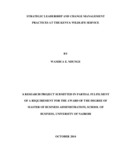| dc.description.abstract | This study had two main objectives of establishing strategic leadership and change
management practices at the KWS and establishing the challenges of leadership strategies
on change management practices at the KWS. The study was carried out through case
study focusing on KWS and the strategic leadership being practiced and the change
management process that was undertaken at the organization to turn around its business
fortunes. Primary data was collected from the respondents through interview guide and
key informant interviews. A total of 8 interview guides were sent out and administered
out of which, 6 were responded to and 2 did not respond. Secondary data from
respondent organization, reports and past strategic plans was used to verify and validate
the primary data. The data collected was analyzed using content analysis in order to meet
the study objectives. This study revealed that KWS had a vision and mission that is
shaped by the law governing wildlife conservation and management in the country and
the vision, mission and mandate are then communicated through strategic plans, work
plans, sensitization to inform all members of staff. It was also determined that KWS
undertook change programme, and that the change was necessitated by low staff morale,
poaching, and fraud, financial constraints/ corruption, poor performance, the lack of
passion to deliver on the mandate and changing work environment. Activities that were
rolled out as change program were strategy formulation, culture change, staff retraining
and branding of parks and reserves across the country, review of the organizational
structure, review of policy and law, participation in COYA awards, realignment of
functions, documentation of procedures/ processes leading to ISO certification,
awareness, coaching, training, role play/modelling and appointment of champions.
Respondents noted that change was undertaken since management provided strategic
leadership as well as support to the process. This is in line with literature as observed by
Rowe (2001), that strategic leadership presumes a shared vision of what an organization
is to be, so that the day-to-day decision making or emergent strategy process is consistent
with this vision. This study recommends that strategic leadership must make change a
continuous process and should be well communicated and known by the entire
organization including the new comers in to the system. This way the organization does
not run the risk of old habits that the organization was running away from and also the
KWS should prioritize shared values and a clear vision which are important aspects of
strategic leadership enabling and allowing employees to make decisions with minimal
formal monitoring or control mechanisms. This study offered insights into strategic
leadership as key to driving change management offer lessons to professional and
practitioners of strategic leadership. The research findings addressed the questions under
investigation and the objectives of the study. The implication of the study was to
establish the importance of strategic leadership in driving change and the results are
going to add value to theory, help academia and practitioners to understand, apply and
replicate the findings. | en_US |

